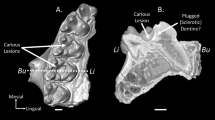Abstract
Maat & Van der Velde (1987) have argued that a generalizable relationship exists between dental attrition and caries rates. They postulated a negative correlation between the two variables; lower rates of caries were associated with higher rates of attrition. They based this conclusion upon an analysis of data from a 17th and 18th century Dutch whaling station on Spitzbergen, together with a survey of literature on European populations over the last thousand years. In this paper we present data from two Portuguese Mesolithic sites questioning the universality of those conclusions. We find a consistently positive correlation between the two variables; higher caries rates are associated with higher attrition rates. The solution to this conundrum appears to be that neither caries nor attrition are directly dependent upon each other. Rather, both are correlated with diet. Different series with different dietary regimes will show different relationships between these two variables, each of which will have to be analyzedde novo.
Similar content being viewed by others
References
Borgognini-Tarli, S. &Repetto, M., 1985.Dietary patterns in the Mesolithic samples from Uzzo and Molara Caves (Sicily): the evidence from teeth. Journal of Human Evolution, 14: 241–254.
Brothwell D., 1981.Digging Up Bones. 2nd ed. London: British Museum (Natural History).
Hillson S., 1986.Teeth. Cambridge: Cambridge University Press.
Lubell D. &Jackes M.K., 1988.Portuguese Mesolithic-Neolithic subsistence and settlement. Rivista di Antropologia, 66 [supplement]: 231–248.
Lubell D., Jackes M.K., Schwarcz H. &Meiklejohn C., 1986.New Radiocarbon dates for Moita do Sebastião. Arqueologia, 14: 34–36.
Lubell D., Jackes M.K. &Meiklejohn C., 1989.Archaeology and human biology of the Mesolithic-Neolithic transition in southern Portugal: a preliminary report. In: The Mesolithic in Europe (ed. C. Bonsall), pp. 632–640. Edinburgh: John Donald.
Maat G.J.R. &Van der Velde E.A., 1987.The caries-attrition competition. International Journal of Anthropology, 2: 281–292.
Meiklejohn, C. & Zvelebil M.,1991 Health status of European populations at the agricultural transition and the implications for the causes and mechanisms of the adoption of farming. In: Health in Past Societies (eds. H. Bush & M. Zvelebil). British Archaeological Reports (International Series), 567:129–146.
Meiklejohn C., Baldwin J.H. &Schentag C.T., 1988.Caries as a probable dietary marker in the Western European Mesolithic. In: Diet and Subsistence: Current Archaeological Perspectives (eds. B.V. Kennedy & G.M. LeMoine), pp. 273–279, Calgary: University of Calgary.
Smith B.H., 1984.Patterns of molar wear in hunter-gatherers and agriculturalists. American Journal of Physical Anthropology, 63: 39–56.
Author information
Authors and Affiliations
Rights and permissions
About this article
Cite this article
Meiklejohn, C., Wyman, J.M. & Schentag, C.T. Caries and attrition: Dependent or independent variables?. Int. J. Anthropol. 7, 17–22 (1992). https://doi.org/10.1007/BF02445038
Issue Date:
DOI: https://doi.org/10.1007/BF02445038




